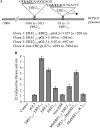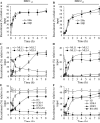HOXC6 Is transcriptionally regulated via coordination of MLL histone methylase and estrogen receptor in an estrogen environment
- PMID: 21683083
- PMCID: PMC3143278
- DOI: 10.1016/j.jmb.2011.05.050
HOXC6 Is transcriptionally regulated via coordination of MLL histone methylase and estrogen receptor in an estrogen environment
Abstract
Homeobox (HOX)-containing gene HOXC6 is a critical player in mammary gland development and milk production, and is overexpressed in breast and prostate cancers. We demonstrated that HOXC6 is transcriptionally regulated by estrogen (E2). HOXC6 promoter contains two putative estrogen response elements (EREs), termed as ERE1(1/2) and ERE2(1/2). Promoter analysis using luciferase-based reporter assay demonstrated that both EREs are responsive to E2, with ERE1(1/2) being more responsive than ERE2(1/2). Estrogen receptors (ERs) ERα and ERβ bind to these EREs in an E2-dependent manner, and antisense-mediated knockdown of ERs suppressed the E2-dependent activation of HOXC6 expression. Similarly, knockdown of histone methylases MLL2 and MLL3 decreased the E2-mediated activation of HOXC6. However, depletion of MLL1 or MLL4 showed no significant effect. MLL2 and MLL3 were bound to the HOXC6 EREs in an E2-dependent manner. In contrast, MLL1 and MLL4 that were bound to the HOXC6 promoter in the absence of E2 decreased upon exposure to E2. MLL2 and MLL3 play key roles in histone H3 lysine-4 trimethylation and in the recruitment of general transcription factors and RNA polymerase II in the HOXC6 promoter during E2-dependent transactivation. Nuclear receptor corepressors N-CoR and SAFB1 were bound in the HOXC6 promoter in the absence of E2, and that binding was decreased upon E2 treatment, indicating their critical roles in suppressing HOXC6 gene expression under nonactivated conditions. Knockdown of either ERα or ERβ abolished E2-dependent recruitment of MLL2 and MLL3 into the HOXC6 promoter, demonstrating key roles of ERs in the recruitment of these mixed lineage leukemias into the HOXC6 promoter. Overall, our studies demonstrated that HOXC6 is an E2-responsive gene, and that histone methylases MLL2 and MLL3, in coordination with ERα and ERβ, transcriptionally regulate HOXC6 in an E2-dependent manner.
Published by Elsevier Ltd.
Figures








References
-
- Yu BD, Hess JL, Horning SE, Brown GA, Korsmeyer SJ. Altered Hox expression and segmental identity in Mll-mutant mice. Nature. 1995;378:505–8. - PubMed
-
- Alexander T, Nolte C, Krumlauf R. Hox genes and segmentation of the hindbrain and axial skeleton. Annu Rev Cell Dev Biol. 2009;25:431–56. - PubMed
-
- Chen H, Sukumar S. HOX genes: emerging stars in cancer. Cancer Biol Ther. 2003;2:524–5. - PubMed
-
- Friedmann Y, Daniel CA, Strickland P, Daniel CW. Hox genes in normal and neoplastic mouse mammary gland. Cancer Res. 1994;54:5981–5. - PubMed
Publication types
MeSH terms
Substances
Grants and funding
LinkOut - more resources
Full Text Sources
Research Materials
Miscellaneous

